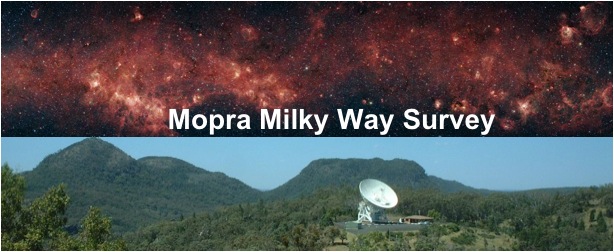Mopra Milky Way Survey Meeting
Monday 3 November 2008
Final Program (pdf format)

Momentum is building for the Australian millimetre community to embark on a millimetre-line Galactic Plane Survey using the Mopra telescope. A survey of multi-molecular-line species with arcminute or lower angular resolution is long overdue and the Mopra Telescope is the perfect instrument to use for such a large-scale study.
The Mopra Spectrometer (MOPS)* offers an unprecedented 8-GHz instantaneous bandwidth and with the added capability of on-the-fly mapping, Mopra is now a world-class facility operating at 3, 7 and 12-mm and remains the only single-dish telescope in the Southern Hemisphere to be operating in the 3 & 7-mm wavebands. Mopra's niche in star-formation studies is its ability to collect data on the lower-state molecular-line transitions, which are important for chemical modeling and the easiest to detect. These data complement those from the new single-dish facilities built in Chile (ASTE, APEX, NANTEN, which do not operate below the 1-mm waveband). The profile of Mopra has risen considerably in the past two years, particularly in the International Community. More than 90 percent of Mopra projects in the APR08 semester were led by overseas investigators and more than half of these had no Australian collaborators. Undertaking a millimetre-line survey of the Milky Way for open release is a way for the Australian Community to boost its profile and provide a much-need molecular-line database that will form the basis of follow-up studies with ATCA and ALMA.
The composite survey by Dame, Hartmann and Thaddeus (2001, ApJ, 547. 792) remains the only molecular-line dataset offering complete coverage of the Milky Way. Spectra contain the single transition of CO(1-0) 115 GHz and have been either smoothed or interpolated to a 7.5-arcmin grid. Despite the modest angular resolution this survey continues to be widely used and cited**. The subsequent NANTEN Survey (available for collaborative projects with the Nagoya team) also provides spectra of the single CO(1-0) 115 GHz transition yet with higher angular resolution (between 4 arcmin and 8 arcmin) but limited to the Galactic Plane. Mopra can do better than both of these surveys. With the 8-GHz bandwidth capability of MOPS, Mopra can provide multiple molecular-line transitions (including bright maser transitions) simultaneously and at angular resolutions of 2, 1 or 0.5 arcmin at wavelengths of 12, 7 or 3 mm, respectively. A southern galactic-plane survey in either of these three wavebands with Mopra will produce a dataset with the highest angular resolution available and will for the first time enable large-scale chemical analyses.
As a first step in the planning of the Mopra Milky Way Survey (MMWS) a 1-day meeting will be held on 3 November 2008. The aim of the meeting is to identify the science drivers for different molecular-lines in the 3, 7 and 12-mm wavebands as well as to arrive at a decision on the best central frequency to use for the MMWS (keeping in mind that the 8-GHz wideband allows many molecular species to be observed simultaneously). The minimum velocity resolution and sensitivity of the survey must also be decided. To facilitate discussion there will be a series of contributed talks from the community about targeted millimetre-line studies that are currently underway as well as the science to be gained from studying particular line transitions. Before embarking on the the full MMWS further enhancements to improve the survey speed of the current Mopra system are required. These may include bandwidth enhancements, multibeam systems, online software improvement for automated observing as well as an offline data reduction pipeline and online archive. The outcome of the 1-day meeting will feed into the science case to support these future developments.
We should be limited in our aspirations only by science cases for the unique science that Mopra can do. We should be mindful of ATNF priorities, and work closely with ATNF in proposing new facilities and projects, including giving ATNF plenty of lead time to consider and give input to our requests.
More information about Mopra is available in the online guide Information for Mopra Observers.
* MOPS was funded in part through a grant instigated by the University of New South Wales (UNSW) under the Australian Research Council Grants scheme for Linkage, Infrastructure, Equipment and Facilities (LIEF), and in part by CSIRO-ATNF.
* * The second most cited radio astronomy paper of the year in Table 1 of Trimble & Zaich (2006) on the "Productivity and Impact of Radio Telescopes" and citations have increased every year since its publication to a peak of 79 in 2007.
ORGANISERS
Kate Brooks and James Urquhart
VENUE
Main Lecture Theatre
Australia Telescope National Facility Headquarters
Marsfield (Sydney) NSW Australia
Teleconferencing and Videoconferencing are available. Please contact Kate Brooks for the access numbers.
DATE
Monday 3 November 2008
WEBSITE
The meeting website is http://www.narrabri.atnf.csiro.au/mopra/Survey/SurveyMeeting.html
PROGRAM
The Final Program (pdf format) is now available.
ENQUIRIES
Email: Kate.Brooks @ csiro.au
CONTRIBUTED TALKS
Download the presentations from here.REGISTRATION
There is no formal registration. All those interested are invited to attend. For catering purposes (morning and afternoon tea) please email Kate Brooks with your intention to attend the workshop and any dietary requirements you may have.
View the list of participants (locally) .
TRAVEL & ACCOMMODATION
Marsfield is a residential suburb about 25 km north-west of
the centre of Sydney. Accommodation is available at a number of nearby University Colleges and
Hotels. Participants are responsible for their own travel and accommodation arrangements. Further
information is available in the online Visitors Guide to the ATNF
Headquarters.